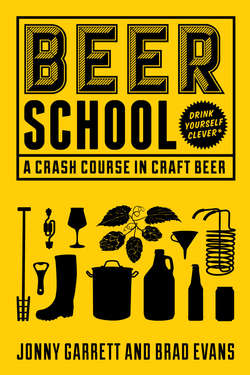Читать книгу Beer School - Jonny Garrett - Страница 15
На сайте Литреса книга снята с продажи.
ОглавлениеAll beers start in a brewer’s head. It could be a craving for grapefruit, a weird idea about peanuts, or the ambition to make the best pilsner ever. Their skill as a brewer is how he or she translates that ambition into liquid.
But before we get to that we must recognize that the original idea has to be a great one. Even if no one else thinks it’s great, that conviction and clarity of concept is hugely important. This is the first lesson in brewing.
When you look back at the breweries that have made the biggest impact, it’s clear to see that the concept was sound. Let’s take America’s meteoric rise in the beer world as an example. It was started by just a few people, in some cases in their living rooms. Humble beginnings but big ambitions. Jim Koch of Boston Brewing Company decided that lager didn’t need to be dumbed down to be enjoyable. Ken Grossman of Sierra Nevada discovered the power of American hops and set out to show everyone what they could do. Goose Island’s Greg Hall wanted to combine the big-flavoured beer with the American traditions of barrel-aging whisky.
All three of these ideas are brilliant – the kind of ideas that make you wonder how they had never been done before. The kind of idea that leaves you kicking yourself because it wasn’t you that came up with it. They had the power to change the course of brewing, and they created three cracking beers that prepped the market for thousands of others to do the same.
With the brewing world blown wide open there are ideas cropping up all over the place. What started as a very American revolution has spread across the globe. That’s been fantastic for the quality of beer we can drink, but it’s made standing out a lot harder. Now the ideas seem much more subtle, while setting yourself apart has become even more important. It could be dry-hopping at an unusual time to create a new style, adding ingredients no one has thought of using, or reverting back to fermenting in slate and wood like we did centuries ago.
I’m alluding to a lot of famous breweries here, but none of these guys were the first to think of these things. If you want to see future trends in beer, look to the home brewers. They are the guys experimenting in their garages with no commercial or time pressures. They make beer just for themselves, and they can experiment without the worry of wasting huge amounts of ingredients, time or money. There’s not a brewery in the world that doesn’t have at least one brewer who started at home with a massive pan, a plastic spoon and a head full of dreams.
HUNDREDS, MAYBE THOUSANDS
Jim, Ken and Greg probably had their ideas at the same time as a thousand others, but these were the guys who managed to convey that great idea in a beer. They took a concept and by chance or design made it look, feel and taste special. The beer in their heads became the beer in the glass, which is a much harder process than your average drinker realises. Even before you get to the art of it, the science is tough enough.
The Brad and I are often asked what makes a great brewery. It took years to find a satisfactory answer and, sadly, it wasn’t either of us who first said it. It was Sam McMeekin, the cofounder of Gipsy Hill Brewing Company, who noted that a great brewery does everything 1% better than its nearest rival. I love that idea.
